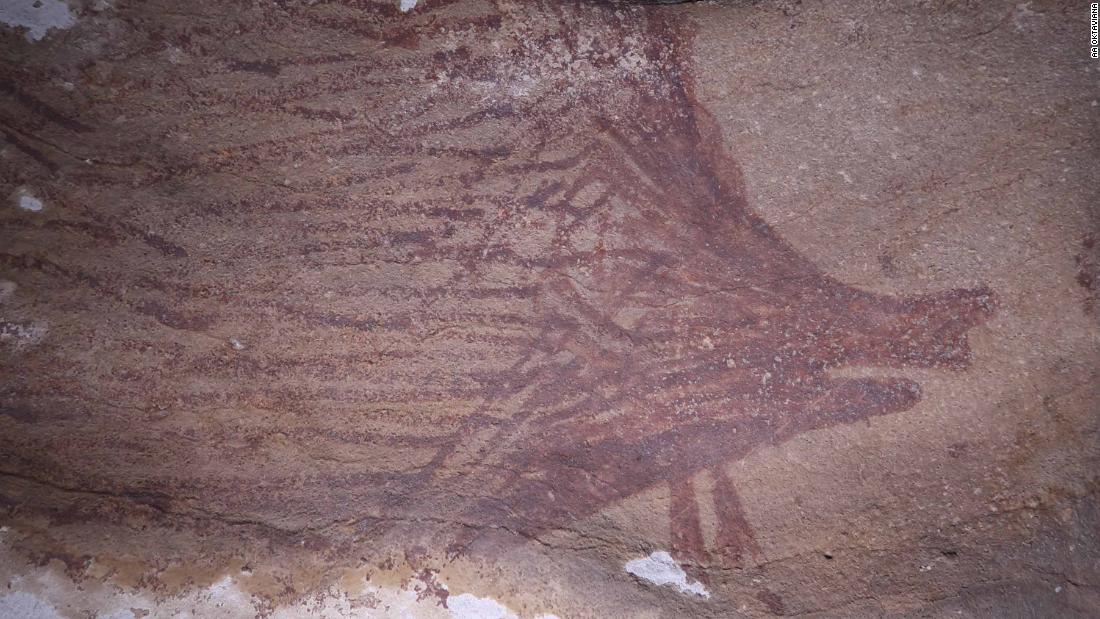The oldest known figurative work of art in the world was discovered in a cave in Indonesia – a captivating image of a warty pig.
Archaeologists working at the site on the island of Sulawesi said the rock art was at least 45,500 years old. It is also considered the oldest image of an animal that survived. Painted with ocher red pigment, the animal appears to be watching a fight or social interaction between two other warty pigs.

Painted in red ocher, the scene shows a warty pig watching other warty pigs fighting or otherwise interacting. Credit: Basran Burhan
Previously, the oldest known rock art was thought to have first appeared in Europe 40,000 years ago, exhibiting abstract symbols. 35,000 years ago, art became more sophisticated, exhibiting horses and other animals.
These latest discoveries in Indonesia challenged a long-held belief that artistic expression – and the cognitive leap that may have accompanied it – started in Europe. Cave paintings in Indonesia are shedding new light on human history.
The study’s co-author, Maxime Aubert, an archeologist and associate professor at Griffith University in Australia, who specializes in rock art dating, said that view was “Eurocentric”.
It is now thought that the ability to create figurative art – which makes reference to the real world – arose before Homo sapiens migrated out of Africa and went to Europe and Asia, more than 60,000 years ago, or that it arose more than once with the spread of humans across the globe.
Dated rock art
One reason for this may be because it is particularly difficult to date rock art, explained Aubert. However, rock art made in limestone caves can sometimes be dated by measuring the radioactive decomposition of elements such as uranium in calcium carbonate deposits – sometimes called cave popcorn – that naturally form on the surface of the cave. .
This was the case at Leang Tedongnge, in southern Sulawesi, where a small cave popcorn formed on the back leg of the pig’s figure after being painted. The date indicates that the scene was painted before 45,500 years ago, said Aubert, and the cave art could have been much older.
A second image of Sulawesi’s warty pig, from another cave in the region, was dated at least 32,000 years ago using the same method in the study published in Science Advances on Wednesday.

A second depiction of a warty pig in another cave was dated at least 32,000 years ago. Credit: AA Oktaviana
The team hopes that future research in eastern Indonesia will lead to the discovery of much older rock art and other archaeological evidence, dating back at least 65,000 years.
“We found and documented many images of rock art in Sulawesi that are still awaiting scientific dating. We hope that the oldest rock art on this island will produce even more significant discoveries,” said study co-author and Indonesian rock art expert Adhi Agus Oktaviana , a doctoral student at Griffith University.

Steep limestone cliffs surround the limestone cave where the painting was found. The cave is only accessible through a narrow passage in the dry season. Credit: AA Oktaviana
Prehistoric picassos
The researchers were confident that the image was of a warty pig, which is shown in profile and filled with irregular patterns of painted lines and strokes, because of the presence of sharp ridges on the head and facial warts – the two conspicuous protrusions shaped like horn in the upper snout area.
The painted pig on the cave ceiling measures 187 centimeters (6 feet) long and 110 centimeters (3.6 feet) high and is a red or blackberry color – prehistoric artists used iron-rich rock as a pigment and could have used two colors. The researchers said there are three other pigs on the scene.

The researchers were confident that the image was of a warty pig because of the two conspicuous horn-shaped protrusions in the upper snout area. Credit: AA Oktaviana
Warty pigs are still common in Indonesia and have since been domesticated.
Not much is known about the people who made the art, Aubert said.
The research indicated that Homo sapiens arrived in Southeast Asia between 60,000 and 70,000 years ago. Although the researchers say they cannot definitively conclude that the work of art is the work of cognitively modern humans, this was the most likely explanation.
“Our species must have crossed Wallacea in vessels to reach Australia at least 65,000 years ago,” said Aubert, referring to the region between mainland Asia and Australia.
“However, the Wallacean islands are poorly explored and, today, the first archaeological evidence excavated in this region is much more recent.”
“This discovery highlights the remarkable antiquity of rock art in Indonesia and its great significance for understanding the history of art in deep times and its role in the early history of humanity,” said study co-author Adam Brumm, professor at the Center of Australian Research for Human Evolution of Griffith.
